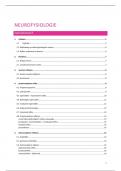Summary
Neurofysiologie samenvatting (16/20)
Course
Neurowetenschappen
deze samenvatting bestaat uit de 6 besproken hoofdstukken uit de lessen neurofysiologie. ze zijn samengevat aan de hand van de powerpoints en de notities uit de lessen van prof Van Dam. ik heb 16/20 gehaald door deze samenvatting te studeren.
[Show more]
Last document update: 1 year ago
Preview 4 out of 79 pages
Uploaded on
May 16, 2023
File latest updated on
July 9, 2023
Number of pages
79
Written in
2022/2023
Type
Summary
neurofysiologie
debby van dam
Institution
Universiteit Antwerpen (UA)
Education
Biomedische Wetenschappen
Course
Neurowetenschappen
All documents for this subject (46)
By: jonaswinckelmans • 6 months ago
By: marie-madeleinentumba • 9 months ago
$9.37
100% satisfaction guarantee
Immediately available after payment
Both online and in PDF
No strings attached
NEUROFYSIOLOGIE




